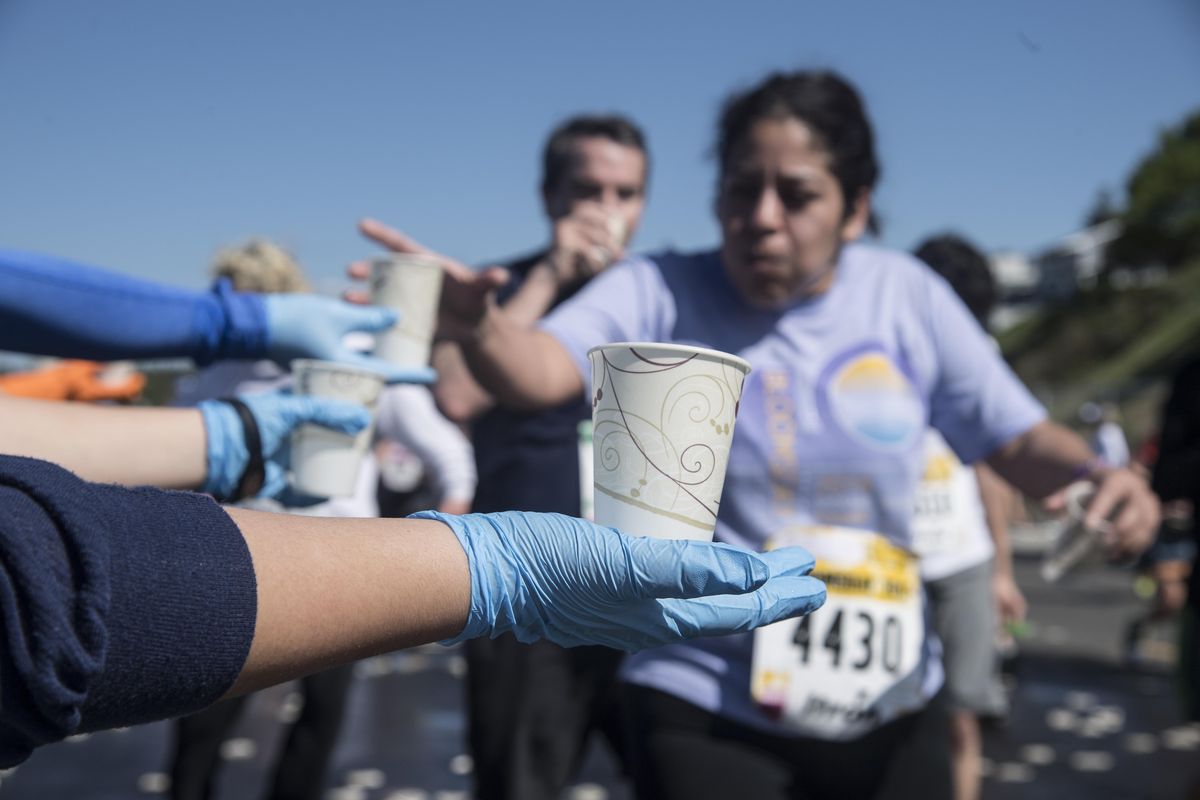Late Bloomers: Sleep, hydration, comfy shoes will help make a last-minute decision to do Bloomsday a successful one

So you signed up at the last minute for Sunday’s Bloomsday Run.
At least the “run” part is optional. As a late Bloomer, you can take steps to avoid a medical-aid station detour, or worse, a collapse at the vulture feet on Doomsday Hill.
Assuming you’re reasonably healthy, it’s best to go easy and don’t fret if you haven’t trained, said Don Kardong, Bloomsday race director. Many in the crowd of 50,000 aren’t fitness regulars.
“Plan on walking, rather than running or jogging, if you’re someone who hasn’t done any training,” Kardong said.
“Most of us can walk a fairly long way, even if we haven’t done any specific walking to get ready. By the top of Doomsday Hill, expect to be plenty tired. Fortunately, it’s all flat from there.”
And plenty of people complete the course just fine without intense fitness beforehand, if they don’t push too hard, he added.
“We have people every year – young people, that is – who do Bloomsday without any training. They do all right on Bloomsday; they just walk funny for a week afterward.”
Adults who haven’t exercised much should start a bit slower than they’d expect, Kardong said.
“Easier than they think they need to,” he said. “There’s plenty of challenging territory ahead, so they should save as much energy as they can for the hills midrace.
“If they’re running and need to walk, they should walk. We ask people who need to walk to stay to the right side of the roadway, so runners or faster walkers can pass on the left.”
At a minimum: Wear sunscreen, comfortable clothing and reliable shoes to avoid the most common first aid complaints – blisters and chaffing – treated by Bloomsday medical volunteers, said Cynthia Wright, Whitworth University Athletic Training program director.
She’s running Bloomsday this year, but Wright is an athletic trainer who has volunteered with Whitworth students the past three years at one of the several race medical stations. Comfort rises above needing to “break in” shoes that are relatively new, Wright added.
“It’s mostly making sure you’re accustomed to them; that you go out in them a couple times, but if you realize they are rubbing, you don’t want that to be a couple of miles into Bloomsday.”
Sunscreen is commonly overlooked this time of year.
“Look at the weather, and if it’s warm and sunny, another thing people frequently come into medical tents for is sunscreen,” Wright said. “Be prepared if it’s the first time this season you’re going to wear a tank top.”
Heidi Peterson, Rockwood North Orthopedics & Sports Medicine licensed athletic trainer, suggests having a plan for how you’ll run or walk – even if you haven’t trained. Problems can crop up if you run at a slower gait than normal, she said.
It’s key to maintain a good form while running or walking, she said, and to go at your normal pace. It’s even OK to run and then walk to recover.
“Let’s say the longest you’ve run lately is 3 miles, but you have a certain pace you normally run at,” Peterson said. “Sometimes people think, I’ll just run more slowly. Sometimes when you run slower, you change your mechanics.
“You start shuffling or swinging your legs, and that can cause hip, knee and foot pain.”
She also suggests you don’t get caught up in the excitement of the race’s start, and go out too hard. You’ll be exhausted before uphill and downhill excursions. Leaning too far forward as you ascend all of Doomsday Hill isn’t good idea either, likely resulting in next-day soreness.
During race time, definitely be willing to stretch or rest if needed, Peterson said.
“Altering your form to accommodate a pain or feeling of tightness isn’t a good idea,” she said. “Walk, move, stretch and return to running when the pain or tightness resolves.”
You can bring bandages as a precaution, but medical stations provide those along with extra sunscreen, Wright said. With three days left, people won’t benefit from exertion before the race.
“Obviously, between now and Sunday, they’re not going to have huge fitness gains, so going out and doing hard runs will probably be counterproductive,” Wright said.
“Some things that will make a difference, if they’re generally active, are to make sure they have proper shoes and clothing; maybe go for a walk or jog in the clothes and shoes that they plan to wear. Then, thinking about getting proper rest and nutrition.”
Your next few meals don’t need to include any special nutrition or carbohydrate loading. Just eat healthy and drink water regularly the next few days. Also, plan to take water at the aid stations along the course.
“Don’t start the course dehydrated,” Wright cautioned. She also urged participants to get a good night’s rest before the race, “so they’re feeling good on Bloomsday morning.”
Peterson also encourages good sleep, hydration, along with good nutrition in the next few days. And on race day, enjoy.
About 30 bands line the course, and many people go at a pace that lets them enjoy the music, funny costumes and Spokane’s scenic views.
“It’s better to finish feeling good and looking forward to your next run or walk,” Peterson said. “That finisher T-shirt will look just as good on Monday, no matter what time you finish.”

